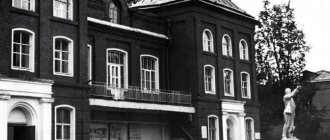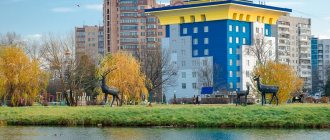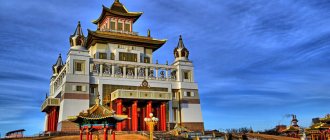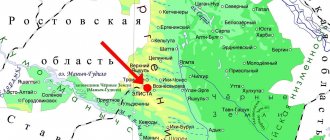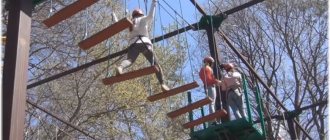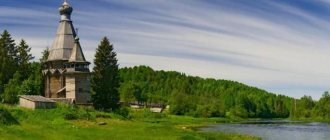LiveInternetLiveInternet
Monday, January 16, 2022 10:59 + to quote book Nadezhdaaa
all posts by the author Let's continue our walk around Yelets. But now our road leads to the temple. It’s an amazing city - no matter what road you take, you’ll still come out to the temple!
The travel agency calls Yelets a city of 33 churches! As of today, I read that there are only twelve operating temples left. Is it so? I don’t know... Do you and I need to do this arithmetic? It’s better to go and look at the temples that we met on the way that day. Let's start with the main attraction of the city - the Ascension Cathedral in the Russian-Byzantine style. It is one of those in Russia that amazes in size, like the Cathedral of Christ the Savior in Moscow and St. Isaac's Cathedral in St. Petersburg.
It was built in 1845, it was designed and supervised by Konstantin Andreevich Ton, by the way, the author of the Grand Kremlin Palace, the Armory and the Cathedral of Christ the Savior! Since then, the building has been reconstructed many times.
Emperor Nicholas I ordered that the architect Konstantin Ton be given royal favor for the beauty of the Ascension Cathedral project.
In the 1930s, the cathedral suffered the same sad fate as many other churches in our country. The icons were destroyed, burned right in the temple, all valuables were taken away, and the building was turned into a warehouse. The Grand Ducal Church will not be inferior in beauty and grandeur. It was erected in 1911 in honor of the 300th anniversary of the reign of the Romanov dynasty. The author of the project is the architect E.E. Wilfahrt.
The church was dedicated to the holy princes Mikhail of Tver and Alexander Nevsky and was built as a temple for the society of banner bearers.
The name of the merchant of the first guild A.N. Zausailov, who supplied shag to the Court, which assumed all the costs of building this temple, will forever remain in the history of the city.
Church of Michael the Archangel in the Russian-Byzantine style with a refectory and bell tower (1788).
Closed in the 1930s and used as a warehouse. In the 1990s it was returned to believers. Now they are trying to restore it.
The Church of the Intercession of the Blessed Virgin Mary was built according to the design of the architect A. A. Ton at the expense of the parishioners.
Closed in the early 1930s, used as a granary, then as a warehouse, and the bell tower was demolished in the 1960s. In 1997 it was returned to believers.
Church of the Transfiguration of the Lord. By the middle of the 18th century. The wooden Transfiguration Church became completely dilapidated and then its parishioners - Yelets merchants Stefan Vasilyevich Shaposhnikov, Stefan Yakovlevich Shaposhnikov and Kosma Leontyevich Sergeev in 1761 began to ask Voronezh Bishop Kirill for permission to build a new temple. This church was built and consecrated only in 1771.
In the 30s, workers demanded to close the church and equip a film installation there, because they were in great need of cultural and educational institutions. As a result, it became just another grain warehouse.
The Church of the Assumption of the Blessed Virgin Mary is a two-story stone church in the style of classicism (1815-1829), with an octagonal dome and four small domes.
The refectory connects the temple with a high bell tower, built in 1833-1847. Closed in the 1930s, used as a warehouse. Well, in general, nothing new.
In the 1990s it was returned to believers and renovated.
I wish I had been in this city before the revolution! When all the churches were operational and stood to the joy of the Orthodox in all their beauty, in all their greatness and dignity. Can you imagine what the chime was like at Easter?
| Categories: | architecture/Temples, cathedrals, sacred architecture Across Russia/Across cities and villages travel |
Cited 10 times Liked by: 23 users
Like share
0
Like
- 23
I liked the post - Quoted
- 0
Saved
- Add to quote book
- 0
Save to links
Liked23
0
Temples and monasteries in Yelets
The history of the Yeletsky Trinity Monastery can be divided into two periods. During the first of them - from 1592 to 1775 - the ancient monastery was located on a high cape on the right bank of the river. Elchik, at its confluence with the river. Pine. After its abolition during the reign of Empress Catherine II, the monastery was rebuilt in 1836 in a new location - on the western outskirts of Yelets, behind the outpost, on the Oryol road - where it existed until its closure, which followed shortly after the revolution.in 1919, the Trinity Monastery was closed, and part of its premises were transferred to the proletarian commune. The question of creating a commune was raised as early as January 15, 1919, but it was created no later than March, after the “Bulletin of the Poor” in February 1919 suggested that “nationalized monasteries with model farms should be transferred to Soviet farms.” In connection with the creation of the first proletarian commune on the basis of the monastery, the inhabitants of the Trinity Monastery were pushed out, and then conflicts began, provoked by the “builders of a bright future.”
One of the last solemn church services on the occasion of the patronal feast took place in the monastery on the day of the Holy Trinity on June 13, 1919. At the same time, at their meeting, the communards of the 1st branch of the Yeletsk proletarian agricultural commune unanimously “decided to petition the department. ext. management and the Council of Deputies on the temporary closure" of the monastery church.
By the summer of 1922, the residents of Yeltsov lost the opportunity not only to bury their loved ones in the revered monastery graveyard, but also simply to visit holy graves - according to the Rostovtsevs, “everything there is distorted.”
In subsequent years, there was a gradual destruction of the monastery churches and other buildings, as eloquently evidenced by the decision of the Yelets authorities to satisfy the petition of the commune to build a dairy farm and barnyard from the remaining bricks from the destroyed church of the former monastery.
After the war, the surviving buildings of the former Trinity Monastery belonged to the commune of the Rodina branch of the Yeletsky state farm, and on June 27, 1963, the building of the Tikhvin Church, which was in disrepair, was transferred from the balance of the Yeletsky state farm to the balance of the Yeletsky city council.
On October 18, 1963, by decision of the Lipetsk Regional Executive Committee No. 766-686, all monastery buildings with a total book value of 25,758 rubles. were transferred to the Yeletsstroy trust: residential building (calf barn) - 2311 rubles; warehouse (former church) - 6878 rubles; vegetable storage - 492 rubles; warehouse (former bakery) - 1288 rubles; basement under the bakery - 63 rubles; basement under the forge - 90 rubles; basement under the church - 388 rubles; water tower (bell tower - author's note) - 3045 rubles; fence of the former monastery - 8250 rubles; garage in a fence - 1975 rubles; forge - 978 rub.
Soon after this, the two main churches of the Trinity Monastery were finally destroyed - in 1965 the Trinity Cathedral was blown up, and in 1969 the Tikhvin Church was de-roofed and blown up.
In recent years, the territory of the monastery was occupied by motor depot No. 4, and apartments were built in the fraternal building and the Panteleimon Church attached to it.
SOURCE OF THE TIKHVIN ICON OF THE MOTHER OF GOD
Lipetsk region, Roshchinsky
The Ranenburg Peter and Paul Monastery, or Peter and Paul Hermitage, is famous for its wonderful shrine, which was discovered in our century - this is the healing spring of the Tikhvin Icon of the Mother of God. A holy spring with a bathhouse and a chapel is located under the walls of the monastery. Many pilgrims and those suffering from mental and physical ailments flock here.
The holy spring in honor of the Tikhvin Icon of the Mother of God plays an important role in the life of the monastery courtyard and all those who resort to it. The story of his miraculous appearance is unusual. This happened on the day of the celebration of the Tikhvin Icon of the Mother of God, July 9, 2007. On this holiday, during work to connect two ponds (Mother Neonilla, the abbess of the monastery, wanted to ennoble and adapt them for breeding fish, swans, lotuses) , an excavator removed a layer of earth from which 3 fountains of clean water began to noisily flow, it was the Lord who showed us His miracle. Bishop Tikhon of Yeisk came to the courtyard and, after talking with the workers and examining the place, he offered prayers to the Lord, and blessed to erect the Holy Cross in this place and erect a font for the joy of all suffering Orthodox Christians, travelers, pilgrims and all parishioners.
Lipetsk tourist server https://www.liptur.ru/
Municipal budgetary educational institution secondary school No. 8 in Yelets.
Research work on the topic:
“Non-Orthodox churches of Yelets.” Authors:
Yavorskaya Valeria Valerievna
Grafova Ekaterina Valerievna,
students of class 9 A of MBOU secondary school No. 8
Yelets
Head:
Ershova Irina Aleksandrovna,
history and social studies teacher
MBOU Secondary School No. 8 in Yelets. Consultant
t
:
Lyapin Denis Alexandrovich,
Dean of the Faculty of History of Yerevan State University
Bunin 2012
Contents. Introduction_______________________________________________ 3-4 Chapter 1: Roman Catholic Church._________________ 5-6 Chapter 2: German Lutheran Church._________________ 7-8 Chapter 3: Jewish Synagogue___________________________9-10 Conclusion__________________________________________ 11 List of references and sources______________________ 12 Appendix (photos)________________________13 Introduction.
The ancient Russian city of Yelets is located on the banks of the Bystraya Sosna River. The story of Yelets is heroic and sad at the same time. Many times he was completely destroyed by his enemies. Once upon a time, the Yelets land was the border between Russia and the Horde. People of different nationalities and religions lived here. But, despite this, no written documentary sources indicating that in Yelets until the middle of the 19th century there were any churches other than Orthodox ones have reached us. That is, the Yelets land (since the time of the adoption of Christianity) is purely Orthodox. In the 14th century the city was already practically mono-ethnic. And it remained so until the middle of the 19th century. People of other nationalities began to actively populate Yelets after the peasant reform. Then Jews, Poles, and Germans appeared in the area. At this time, industry began to grow. Many entrepreneurs, the new owners, were foreigners, as they were called then, although they were subjects of the Russian Empire. There were only a few of them: industrialists, doctors, lawyers, traders, jewelers. But in the public life of the city this small “stratum of other faiths” played a significant role. It was then that they had the idea to build a Roman Catholic church, a German church and a synagogue in their new homeland. The temples appeared at about the same time and were located almost in the center of the city.
Today, most residents of Yeltsin have no idea that a residential building on Pushkin Street was once a church, and a building materials store on Ani Gaiterova Street was once a church. The Jewish synagogue has not survived to this day at all.
Nowadays, we often encounter various manifestations of intolerance, and here and there conflicts break out on national and religious grounds.
Today's generations should probably learn from their ancestors to live in peace and respect each other. Therefore, it is quite relevant to study a topic related to the history of people with different religions living together in one Orthodox city. The easiest way to start your research is to study the fate of non-Orthodox churches in the city of Yelets. The purpose of the work is
to study the fate and history of Yelets non-Orthodox churches.
Main objectives:
1) study the history of the appearance of non-Orthodox churches in Yelets based on a study of surviving documents and memories of city residents;
2) study the architectural features of these structures;
3) trace the fate of temples in the history of Yelets.
3
To accomplish these tasks, the following research plan was determined:
I : Search for the location of temples and preliminary analysis of available historical sources; II : Study the architectural features of non-Orthodox churches; III : Meeting and conversation with the residents of the house into which the Catholic church was rebuilt (Roshchupkin A.A. and Burtseva I.V.) IV : Consultations with the dean of the Faculty of History of Yelets State University, D.A. Lyapin. V : Search for additional sources that will allow you to get acquainted with the history and fate of the temples in more detail.
.
4
Chapter 1. Roman Catholic Church
From Polish, the name “kostel” is translated as church. This designation was firmly established initially in the lands of Eastern Europe, especially Poland, the Czech Republic and Slovakia. The church is a small parish church where services are held. But, in Poland, Slovakia and Belarus, only churches belonging to the Roman Catholic denomination are called a church. In other countries, we also use this term for Protestant churches. A church is usually a building with a prayer hall and usually two or one tower. The towers house bell towers, which in the Middle Ages served as observation towers and towers that rang throughout the city, signaling the approach of an enemy to the city walls. In churches it is also allowed to perform various sacraments, from baptism to communion. How did the church appear in Yelets? Most likely, this is due to the presence in the city of the 52nd Nizhyn Dragoon Regiment, which included Catholics - immigrants from Poland, Ukraine and Western Belarus. It was formed in Yelets in 1896. In 1907, the regiment was renamed the 18th Nizhyn Hussar Regiment. The Roman Catholic Church was built on Pushkin Street, 69 (old Starooskolskaya).
Resident of house No. 69 Roshchupkin Alexander Alekseevich, recalling the stories of his parents, says that upon arrival in Yelets, the officers of the Nezhinsky regiment of the Catholic faith felt the need for religious self-expression, so they urgently built themselves a temple, and a house was built next to the temple , where Catholic priests and nuns lived. The temple courtyard was paved with marble tiles.
The Yelets Church in appearance was not much different from similar buildings in Europe. It was a quadrangular building, with a central entrance facing Pushkin Street (today it is bricked up). Above the entrance there was a round window in the shape of a daisy. The roof was crowned with a tall spire with a cross. In the surviving photograph you can see three tall lancet stained glass windows on one side of the temple. The opposite wall was decorated in the same way, as can be seen from the traces of plaster on the red brickwork. The gable roof ended with four high towers at the corners and four lower towers along 5
walls with windows. The bases of the four corner towers still remain. In their upper part, recesses in the form of a pointed arch are clearly visible. The temple was surrounded by a wooden fence with a cross on the gate.
During the Great Patriotic War, in 1941, the building was hit by a bomb. Some say that it is still under the building, but many are inclined to believe that it is just a legend. The walls and upper part of the building were destroyed as a result of the bombing.
In 1947, German prisoners of war rebuilt the destroyed temple into a residential building. This decision was made due to the fact that the building no longer represents any value. The technical passport of this building has been preserved, where it is described as non-residential. From the passport it is clear that at first the house was one-story. There were no interior walls or roof. The building has preserved brick vaults, Gothic wooden windows, plank paneled doors and an altar (brick walls with floor and ceiling), and stove heating. The stone porch remains in very poor condition. The passport also preserves the plan of both the church itself (in the plan it is called a chapel) and the choir. Then the second floor was added and partitions were built. As a result, the house ended up with four two-room apartments, which were given to the war participants.
But even after perestroika, city residents did not forget about the real significance of this house. In the 70s of the 20th century, the house was sometimes visited by a large number of Catholic people who asked the residents to let them walk around the house and pray.
But there were people who came to the territory of the former church not for religious reasons. They believed that treasure could be found on this land, some carried out searches with metal detectors. But no one managed to find the real treasure. However, their search was not fruitless - various antiques were found, among which were also coins of the 19th - 20th centuries. () Residents of the house still find these coins.
6 Chapter 2.
German Lutheran Church.
Separate Lutheran Churches, each of which is independent, are today most widespread in Germany, Scandinavia, the Baltics and the USA.
There are many Lutherans in Latin America and Africa. Most Lutheran Churches are united in the Lutheran World Federation. Lutherans appeared in Russia in the 16th century. Before the October Revolution of 1917, Lutheranism was the second largest Church in the Russian Empire and numbered several million believers, mostly of German origin. During Soviet times, the Lutheran Church in Russia was almost completely destroyed. Only a few scattered communities managed to survive. Churches built in the traditional style are characterized by the division of the building into parts, common for Christian religious buildings. There are such parts as the narthex, which is used for auxiliary church needs, choirs - a space usually located above the entrance to the main room, on which there is often an organ, a nave, in which there is a place for parishioners, a transept, separating the main nave from the altar, where the department is located. Traditionally, there are three main types of building: cathedral, church and chapel .
There was a Lutheran church in the city of Yelets. The fact is that at the beginning of the 20th century Yelets was famous for its brewing. The brewery, founded in 1875, owned by the merchant I.P. Gorshkov, produced a large number of different types of beer. According to documents from 1887, the plant was rented by brewer Karl Karlovich Kronberg, but already in 1901 it was listed in his possession. It was on the territory of the plant, which once belonged to K.K. Kronberg, a German by nationality, and the German Lutheran church is located.
Karl Karlovich did not come to the city alone. He brought with him workers, also Germans, who needed the temple. He built a church for them.
The church has not been preserved in its original form, but the building itself has been preserved. After the country adopted atheistic
religions, a beer hall was located in the church, located on the territory of the brewery. Nowadays there is a store in the former temple
7
building materials. The new owner dramatically changed its “inside”, dividing the hall into two floors. The walls of the church are plastered. However, the appearance of the building was preserved.
The Yeletsk Protestant Church was a rectangular building with a high roof, at the corners of which there were four low turrets with spiers topped with crosses. The top of the roof was crowned with a large cross. There were six attic windows in the roof. The corner turrets were decorated with peculiar recesses in the shape of a cross. Above the entrance and on the back side there were two round windows on the same level. The window above the entrance has been preserved to this day, but the second window is sealed with an iron sheet. Judging by the preserved window, they were made in the shape of a daisy from blue stained glass. On the other two sides there were three tall lancet windows, which still exist today. Under the very slopes of the roof, exactly the same windows, but smaller in size, have been preserved. All decorative parts of the building have a clear symmetrical shape. The temple was surrounded by a decorative fence. The gate was crowned with a branched pattern with a cross.
8 Chapter 3.
Jewish synagogue.
The synagogue is the main institution of the Jewish religion, a building that serves as a place of public worship and the center of the religious life of the community. Externally, synagogues differ from each other. Their internal structure is based on the design of the Temple, which in turn repeated the structure of the Tabernacle, the marching temple of the Jews, which, according to the Bible, was used as a place for making sacrifices and storing the Ark of the Covenant before the construction of the Jerusalem Temple. It was a fenced rectangular space. Inside there was a laver where the clergy washed their hands and feet before starting the service, and an altar for animal sacrifices. Next to this was a kind of tent called the Sanctuary. Only clergy could enter there. In the depths of the Sanctuary, hidden by a special curtain (parohet), was the Holy of Holies. There stood the Ark of the Covenant, containing the Tablets of the Covenant with the Ten Commandments carved on them. When King Solomon built the Temple, he replicated the structure of the Tabernacle, adding an adjacent courtyard where women could pray.
Synagogues are built in such a way that their facade always faces Israel, and, if possible, Jerusalem. The synagogue is usually rectangular in shape, with separate rooms for men and women (this can be a balcony, side or back aisle). There is a sink at the entrance where you can wash your hands before praying. In that part of the synagogue that corresponds to the location of the Sanctuary in the Temple, a large cabinet is installed (sometimes in a niche), covered with a curtain called a parochet. Such a cabinet is called the synagogue ark (aron kodesh) and corresponds to the Ark of the Covenant in the Temple, which contained the tablets of the Ten Commandments. The closet contains Torah scrolls, the most sacred property of the synagogue. In the center of the synagogue there is a raised platform called the bimah or almemar. The Torah is read from this elevation, and there is a table for the scroll on it. This resembles the platform from which the Torah was read in the Temple. Above the ark is a ner tamid - “unquenchable lamp.” Synagogues are completely independent. Any group of believers can organize a synagogue. To manage the synagogue, believers themselves elect leaders. The board of the synagogue manages funds to help those in need, arranges
for overnight stays for visitors, etc. 9 Where did the synagogue come from in Yelets? The answer is quite simple. In the second half of the 19th century, Yelets was an important center of Jewish residence, the number of whom by the beginning of the 20th century exceeded 800 people. Jews took an active part in the life of the city. In 1900, the Jews of Yelets received permission to open a synagogue and some other institutions, and a Jewish cemetery was created. In 1910, a Jewish cemetery in Yelets already existed. In 1915, the city's Jewish population exploded with the arrival of more than 500 refugees from Poland. In 1918, a Jewish school operated.
The Jewish synagogue was located on Pushkin Street (old Starooskolskaya).
It has not survived to this day. After the establishment of atheistic Soviet power, the Yelets synagogue was turned into a bathhouse. On April 27, 1969, it collapsed. Dozens of Yerevan residents died under the ruins. The synagogue was demolished. Now in its place is a brick building with offices and shops. 10 Conclusion .
Studying the history of non-Orthodox churches in the city of Yelets, we came to the conclusion that it is necessary to take care of various architectural structures of a religious nature. They can carry a lot of interesting information about the life of our ancestors, their values, and the nature of relationships with representatives of other religions and nationalities. In the course of the work, photographs preserved in the personal archives of A. A. Roshchupkin and I. V. Burtseva, residents of house No. 69 on Pushkin Street, were studied. A large amount of information was obtained from their stories.
An important source of information was old photographs from 1908, which allowed us to get acquainted with the appearance of the temples and compare them with the appearance of the present time.
Not all tasks set at the beginning of the work were completed. It was not possible to find documents confirming information about the origin and time of creation of the temples. This suggests the need to continue working.
Nevertheless, quite interesting information was collected about the history of the appearance of non-Orthodox churches in Yelets, the architectural features of Catholic and Lutheran churches were studied, and their current state was assessed. The most problems arose when studying the history of the synagogue. Even her photographs could not be found.
There is no talk today about the possibility of restoring these temples. There is apparently no need for their functioning in modern Yelets. But given that Yelets is a city of interest to tourists, it is worth thinking about preserving the remaining religious buildings as monuments of the historical development of the city.
11 List of sources and literature.
- Gorlov V., Novoseltsev A. Yelets has been built for centuries. – Lipetsk publishing house, 1993.
- Memories and stories of the residents of the house on Pushkin Street, 69 Roshchupkina A.A. and Burtseva I.V.
- Personal archive of Burtseva I.V.
Internet resources:
4) https://ru.wikipedia.org
5) https://elets-history.ru/
6) https://www.rujen.ru/index.php/ELETS
12
| Annex 1. |
View of the Roman Catholic Church approx. in 1908.
13
View of a residential building located at 69 Pushkin Street, which used to be a Catholic church, in 2012.
14
| Appendix 2 |
Modern view of the church. Traces of destroyed architectural elements.
15
| Appendix 3 |
View of the house where Catholic priests and nuns lived 16
| Appendix 4 |
Coins found on the territory of a Catholic church
.
17
| Appendix 5 |
View of the German Lutheran Church approx. in 1908
View of a German Lutheran church at the beginning of the 21st century.
18
A building materials store in the building of the German Lutheran Church in 2012.
19
| Appendix 6 |
Lancet windows are the hallmark of the temple.
20
| Appendix 7 |
A round window on the building of the German Lutheran Church.
21
Znamensky TEMPLE IN VESHALOVKA
Lipetsk region, Veshalovka
The warm stone church of the Icon of the Mother of God in the “pseudo-Gothic” style was founded in 1768 by the owner of the Guards estate, captain Yakov Afanasyevich Tatishchev (1725-1806). The church was built and consecrated in 1794. According to the church, the village was called Znamensky.
The author of the project was the then young architect Vasily Ivanovich Bazhenov (1737-1799), although a number of researchers question the authorship. The church is made of red brick and richly decorated with white stone elements. Initially, the bell tower stood separately, but then it was connected to the main building.
During the years of Soviet power, since 1932, the temple was not operational. Repair work began in 1987, the temple reopened only in 2003. While restoring the architectural monument, specialists also took care of the surrounding area - they made a new fence, paths and updated the landscaping.
When visiting the Znamensky Church, tourists are often interested in the fate of the Tatishchev estate next door. Unfortunately, all that remains of it is a beautiful turret and the ruins of a chapel with a family tomb.
